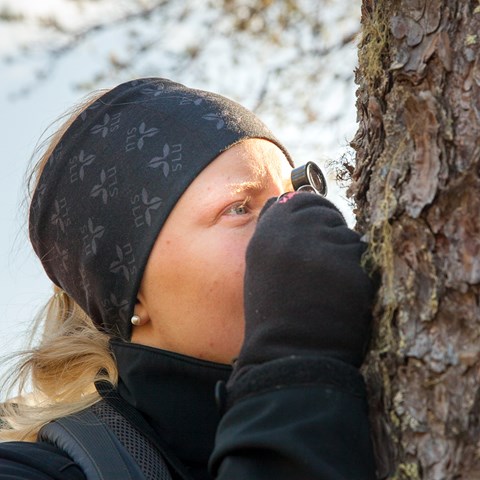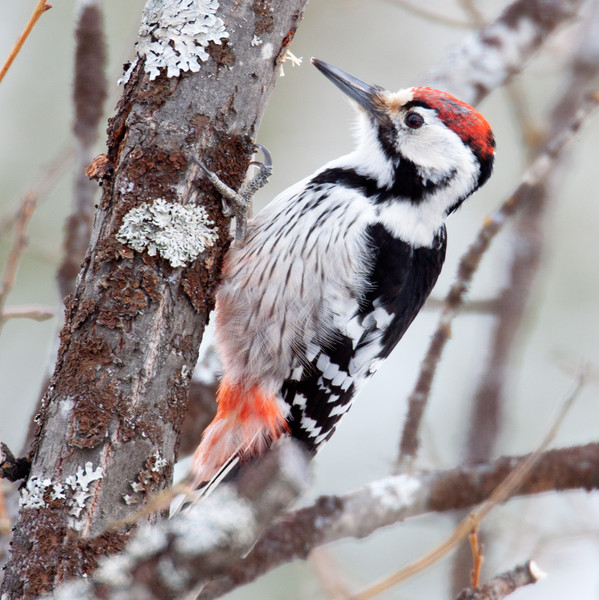Contact
Department of Wildlife, Fish and Environmental Studies

Are you interested in biodiversity, animal movements or how game and fish can be managed in a sustainable way? We have a wide range of bachelor's theses in the subjects forest science and biology!
Bachelor's thesis can be done within the Forester program given at SLU or as an independent course. The scope is 15 credits.
Bachelor's thesis as an independent course is offered all year round and there is a great deal of flexibility in how the work can be set up.
In terms of subject matter, our work and expertise are linked to one of the subject areas at the department:
On this page, we will post information about vacant thesis projects. But you can always contact Therese Löfroth, our contact person for education. She will help you with your idea and put you in touch with the right person.
Welcome to contact us!
Chemical pollution is a recognized threat to wildlife and biodiversity. We know that many chemical pollutants can have a negative effect on animal reproduction and survival, but still wildlife are found living at or near contaminated habitats. This might suggest that chemical pollution could be an ecological trap – meaning animals might be attracted to sources of chemical pollution that also have a negative effect on their reproduction and survival in the long term.
The student will work conducting a systematic literature review assessing what evidence (e.g., published papers, books, reports) already exists in the literature for whether pollution might act as an ecological trap for wildlife.
The student will design and test different search strings in search engines like Web of Science and Scopus. They will they assess which articles are relevant to our research question, and then extract key information from each article (e.g., species studied, type of chemical pollutant, habitat type). We will then summarize and visualize the literature using basic statistics and graphs.
This well-suited for students are interested in a digital thesis project, and for those who are interested in topics like ecology, biology, ecotoxicology, environmental science, or animal behaviour. I encourage you to contact me if you are uncertain and we can discuss project details further.
Erin McCallum
Telephone: +46722014571
E-mail: erin.mccallum@slu.se

White-backed woodpecker. Photo: Jörgen Wiklund
The white-backed woodpecker was a common sight in Swedish forests during pre-industrial times and was found in a large parts of the country. The species needs deciduous forest with a lot of dead wood, and modern forestry, which has focused on conifers and actively controlled broadleaves. As a consequence, the white-backed woodpecker has almost been eradicated from the country. To save the species, large areas of forest have been restored and deciduous forests have been recreated while white-backed woodpeckers are bred in captivity and then released into natural environments. A prerequisite for the white-backed woodpecker to thrive is that there are insects to eat. In this project, you get to evaluate how many insects are produced in stocks that have been restored to benefit the white-backed woodpecker. You can focus on the biological diversity of insects, their ecological function or how much white-backed woodpecker food is produced in restored stands.
Therese Löfroth
Senior Lecturer at the Department of Wildlife, Fish and Environmental Studies
Telephone: +46907868384, +46722289881
E-mail: therese.lofroth@slu.se
Pharmaceuticals are being found in rivers, stream, and lakes around the world making them novel contaminants in aquatic habitats. This is concerning because many pharmaceuticals will likely affect aquatic animals, like fish, that share drug targets (e.g., receptors, enzymes) with humans. Fish could therefore be exposed to drugs in the wild that may change their physiology and behaviour, possibly comprising their ability to survive. To better understand this, we have exposed fish to pharmaceuticals like antidepressants or anti-anxiety medications that are commonly prescribed to humans and are also commonly measured in natural waters. We then record how exposure impacts behaviours important for fish survival in the wild. In particular, we are focusing on fish social behaviours (e.g., aggression, dominance, reproduction).
The student will work will video recordings of fish groups that have been exposed to certain pharmaceuticals. The student will measure different behaviours performed by fish, such as aggression, activity, and feeding. The student will learn how to use behavioural coding computer software and how to input and analyze this data to determine the effect of pharmaceutical exposures, as well as general techniques for conducting animal behaviour experiments. There will also be opportunities to learn how to measure the amount of pharmaceutical that the fish absorb in their tissues (e.g., muscle or brain). Students with who have taken courses and are interested in ecology, biology, environmental science, or animal behaviour would be particularly well-suited. I encourage you to contact me if you are uncertain and we can discuss project details further.
Multiple student positions are available for this project.
Erin McCallum
Researcher at the Department of Wildlife, Fish and Environmental Studies
Telephone: +46722014571
E-mail: erin.mccallum@slu.se
By 2040, Sweden should have an electricity production that fully is based on renewable energy. To access this aim, renewable electricity production needs to be extended (i.e., an increase between 80 and 120 TWh of new renewable production by the year 2045).
An expansion of wind power presupposes ecological, socio-cultural and economic positions and trade-offs. Within the Vindval-funded project “Land-use synergy, integration or conflict in sustainable land-based wind power”, we quantitatively analyze the conditions for large-scale wind power development with existing the national interests (NI, riksintressen) as a point of departure to spatially define possible conflict risks and opportunities for integration and synergy gains with other NIs and other dominant land use.
Using case studies to study the environmental conditions present in municipalities with wind power establishment (i.e. Åsele, Gällivare, Falkenberg, Uppvidinge), we are looking for students who are interested in analyzing and comparing the spatial occurrence of different habitat types, land owner categories, national interests, and protected areas in two municipalities (one in northern and one in southern Sweden).
The students will use existing spatial layers (both shapefiles and rasters). To carry out the spatial analyses required, we are seeking motivated students have good knowledge in Geographical Information System (either ArcMap, QGIS or R).
Supervisors: Wiebke Neumann, Johan Svensson
Wiebke Neumann
Researcher Department of Wildlife, Fish and Environmental Studies
wiebke.neumann@slu.se, +46907868117, +46706349051
Please click the picture below to read one of our previous student's Bachelor's thesis.